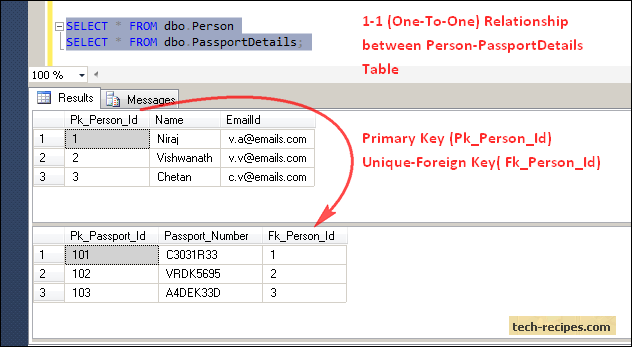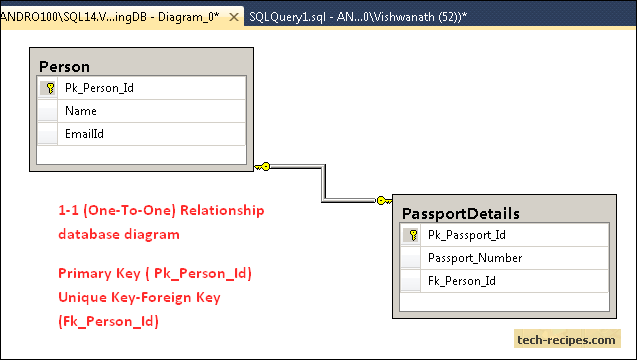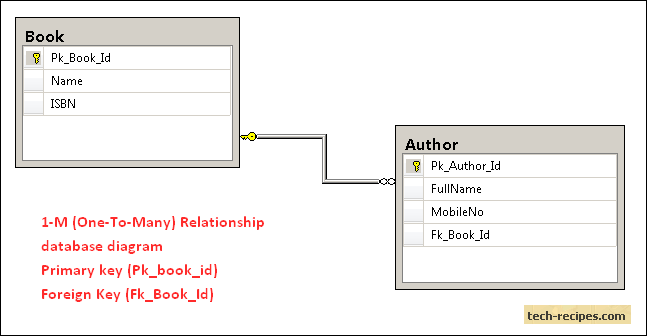Types of Relationships
a. One-One Relationship (1-1 Relationship)
b. One-Many Relationship (1-M Relationship)
c. Many-Many Relationship (M-M Relationship)
b. One-Many Relationship (1-M Relationship)
c. Many-Many Relationship (M-M Relationship)
This tech-recipe covers only 1-1 and 1-M relationship.
1. One-One Relationship (1-1 Relationship)
One-to-One (1-1) relationship is defined as the relationship between two tables where both the tables should be associated with each other based on only one matching row. This relationship can be created using Primary key-Unique foreign key constraints.
With One-to-One Relationship in SQL Server, for example, a person can have only one passport. Let’s implement this in SQL Server.
CREATE TABLE dbo.Person ( Pk_Person_Id INT IDENTITY PRIMARY KEY, Name VARCHAR(255), EmailId VARCHAR(255), ); CREATE TABLE dbo.PassportDetails ( Pk_Passport_Id INT PRIMARY KEY, Passport_Number VARCHAR(255), Fk_Person_Id INT UNIQUE FOREIGN KEY REFERENCES dbo.Person(Pk_Person_Id) ); INSERT INTO dbo.Person VALUES ('Niraj','v.a@emails.com'); INSERT INTO dbo.Person VALUES ('Vishwanath','v.v@emails.com'); INSERT INTO dbo.Person VALUES ('Chetan','c.v@emails.com'); GO INSERT INTO dbo.PassportDetails VALUES (101, 'C3031R33', 1); INSERT INTO dbo.PassportDetails VALUES (102, 'VRDK5695', 2); INSERT INTO dbo.PassportDetails VALUES (103, 'A4DEK33D', 3); GO SELECT * FROM dbo.Person SELECT * FROM dbo.PassportDetails;

One-to-One Relationship is implemented using dbo.Person(Pk_Person_Id) as the Primary key and dbo.PassportDetails(fk_person_id) as (Unique Key Constraint-Foreign Key).

Therefore, it will always have only one matching row between the Person-PassportDetails table based on the dbo.Person(Pk_Person_Id)-dbo.PassportDetails(Fk_Person_Id) relationship.
1. Create two Tables (Table A & Table B) with the Primary Key on Both the tables.
2. Create Foreign key in Table B which references the Primary key of Table A.
3. Add a Unique Constraint on the Foreign Key column of Table B.
2. Create Foreign key in Table B which references the Primary key of Table A.
3. Add a Unique Constraint on the Foreign Key column of Table B.
What happens if we try to insert passport details for the same fk_person_id which already exists in the passportDetails table?
We get an error of Unique key violation.
Msg 2627, Level 14, State 1, Line 1
Violation of UNIQUE KEY constraint 'UQ__Passport__04554C334F12BBB9'.
Cannot insert duplicate key in object 'dbo.PassportDetails'. The duplicate key value is (3).
The statement has been terminated.
2. One-Many Relationship (1-M Relationship)
The One-to-Many relationship is defined as a relationship between two tables where a row from one table can have multiple matching rows in another table. This relationship can be created using Primary key-Foreign key relationship.
In the One-to-Many Relationship in SQL Server, for example, a book can have multiple authors. Let’s implement this in SQL Server.
CREATE TABLE dbo.Book ( Pk_Book_Id INT PRIMARY KEY, Name VARCHAR(255), ISBN VARCHAR(255) ); CREATE TABLE dbo.Author ( Pk_Author_Id INT PRIMARY KEY, FullName VARCHAR(255), MobileNo CHAR(10), Fk_Book_Id INT FOREIGN KEY REFERENCES Book(Pk_Book_Id) ); INSERT INTO Book VALUES (1, 'Let is Snow', 'ISBN3030303'); INSERT INTO Book VALUES (2, 'Three Cups of Tea','ISBN638242'); GO INSERT INTO dbo.Author VALUES(100,'John Green','30303',1); INSERT INTO dbo.Author VALUES(101,'Maureen Johnson','4343',1); INSERT INTO dbo.Author VALUES(102,'Lauren Myracle','76665',1); INSERT INTO dbo.Author VALUES(103,'Greg Mortenson','6434',2); INSERT INTO dbo.Author VALUES(104,'David Oliver Relin','72322',2); GO SELECT * FROM dbo.Book; SELECT * FROM dbo.Author;

One-to-Many Relationship is implemented using dbo.Book(Pk_Book_Id) as the Primary Key and dbo.Author (Fk_Book_Id) as (Foreign Key). Thus, it will always have only One-to-Many (One Book-Multiple Authors) matching rows between the Book-Author table based on the dbo.Book (Pk_Book_Id)-dbo.Author(Fk_Book_Id) relationship.

1. Create two Tables (Table A & Table B) with the Primary Key on both the tables.
2. Create a Foreign key in Table B which references the Primary key of Table A.
2. Create a Foreign key in Table B which references the Primary key of Table A.
No comments:
Post a Comment